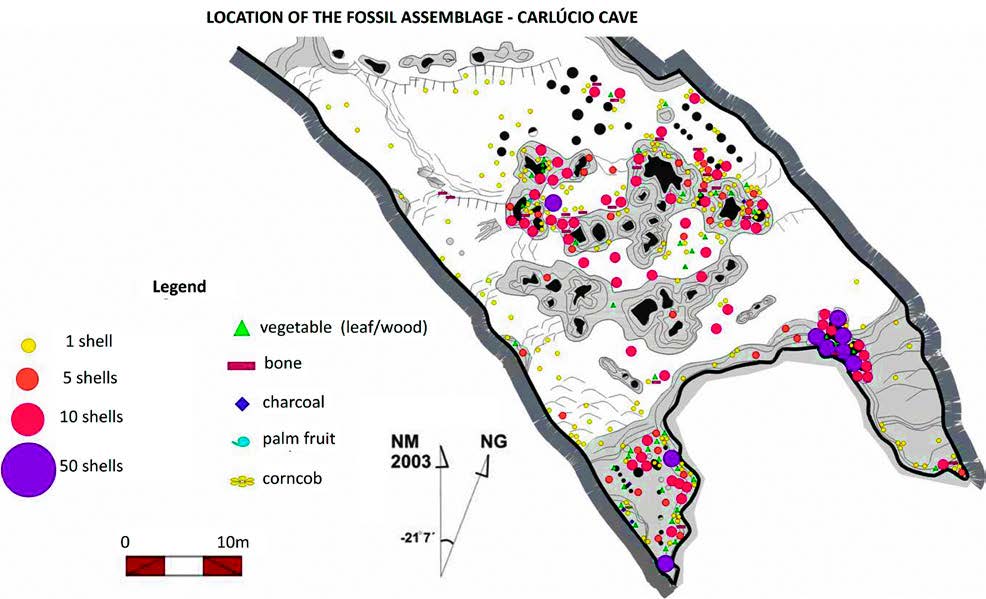Rising water flow as a factor of organic material importation into caves
DOI:
https://doi.org/10.3986/ac.v47i2-3.5134Keywords:
Cave deposits, Holocene chronology, fluvial geomorphology, Peruaçu River canyonAbstract
The Carlúcio Cave is located on the left bank of the Peruaçu River canyon, in a National Park located in the semiarid zone of Minas Gerais, Southeastern Brazil. Although the Carlúcio Cave is in an unfavorable relief position in terms of material importation into its interior, it harbors an important fossil deposit. This paper sought to investigate such fossil assemblage and describe material importation and deposition events. For that purpose, a survey of the existing fossils was conducted, including a description of the deposition sites and taphonomic signatures. A topographic survey was carried out of representative samples and the deposit chronology was established by means of carbon-14 and uranium-series dating. The fossil assemblage comprises mainly terrestrial epigeal mollusk shells, totaling 1,399 individuals, 70% of which are Drymaeus sp. (Bulimuloidea, Bulimulidae). In addition, 20 bones, 57 vegetal deposition sites, four charcoals, one palm fruit and one corncob were recorded. The cave location and morphology and the deposit’s taphonomic signature indicate that the material was carried upward by the rise in water level (WL) of the Peruaçu River due to episodic barriers to the natural river flow, followed by floating and retention of the material once the WL went gradually down. At least four flood events that reached the Carlúcio Cave were identified in the Peruaçu River canyon during the Holocene. This study provides evidence of a mechanism of material transport and accumulation in the cave caused by the rising water flow in connection with flood events in the river canyon.
Key words: Cave deposits, Holocene chronology, fluvial geomorphology, Peruaçu River canyon.
Naraščanje nivoja vode kot faktor vnosa organskega materiala v jame
Jama Carlúcio je na levem bregu kanjona reke Peruaçu v nacionalnem parku na polpuščavskem območju province Minas Gerais v jugovzhodni Braziliji. Čeprav je jama v neugodnem reliefnem položaju glede vnosa materiala, v njej ležijo pomembne fosilne najdbe. Ta članek je poskušal raziskati fosile in opisati dogodke vnosa in odlaganja materiala. Zato smo pregledali obstoječe fosile ter med drugim opisali odlagališča in tafonomske podpise. Izvedli smo topografsko raziskavo reprezentativnih vzorcev ter z določanjem starosti z ogljikom C14 in uranovo serijo vzpostavili depozitno kronologijo. Fosilni ostanki obsegajo predvsem kopenske epigealne mehkužce s 1399 posamezniki, od tega 70 % Drymaeus sp. (Bulimuloidea, Bulimulidae). Poleg tega smo opazili 20 kosti, 57 rastlinskih tališč, štiri oglja, eno palmovo sadje in eno koruzo. Lokacija jame, njena morfologija in tafonomske raziskave sedimentov nakazujejo, da je material odneslo navzgor s porastom nivoja vode reke Peruaçu zaradi epizodnih ovir pri naravnem toku reke. Temu sledi lebdenje in zadrževanje snovi, ko je nivo postopoma upadel. V holocenu smo v kanjonu reke Peruaçu identificirali vsaj štiri poplavne dogodke, ki so segli v jamo Carlúcio. Ta študija dokazuje mehanizem materialnega transporta in akumulacije v jami, ki jo povzroča naraščajoči nivo vode v povezavi s poplavnimi dogodki v rečnem kanjonu.
Ključne besede: jamski sedimenti, holocenska kronologija, rečna geomorfologija, kanjon reke Peruçu.
Downloads

Downloads
Published
How to Cite
Issue
Section
License
Authors guarantee that the work is their own original creation and does not infringe any statutory or common-law copyright or any proprietary right of any third party. In case of claims by third parties, authors commit their self to defend the interests of the publisher, and shall cover any potential costs.
More in: Submission chapter




